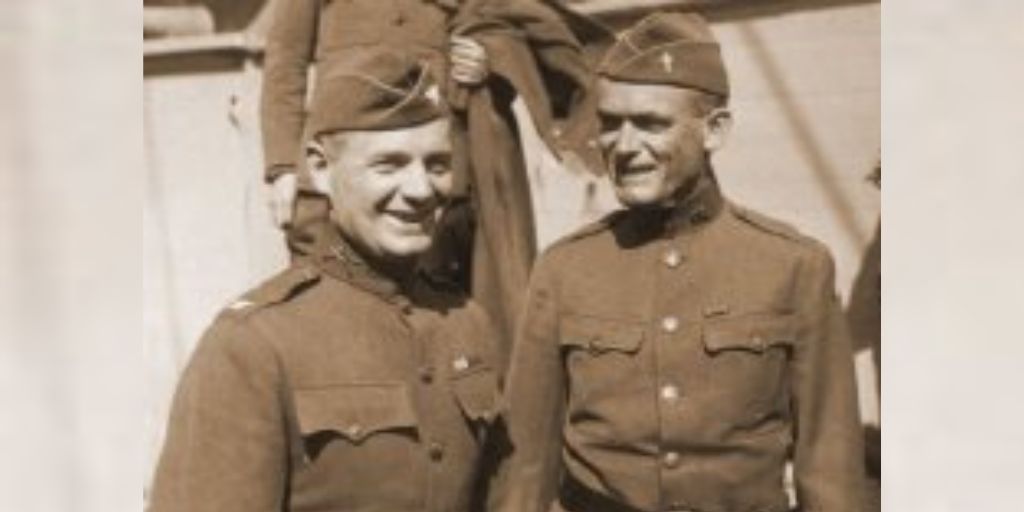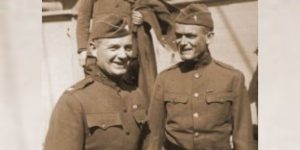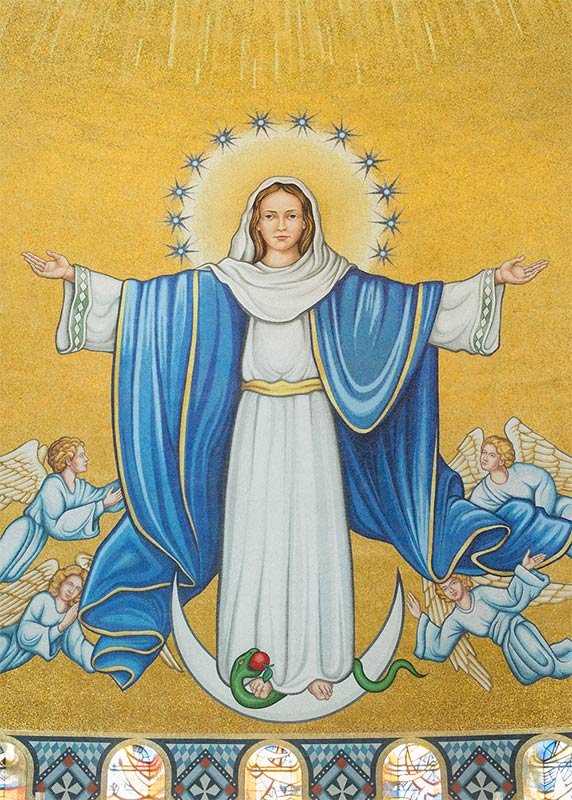
“In Father Duffy’s death the nation has lost one of its great spiritual leaders, a real battler for a higher moral sense among men.”
— Franklin D. Roosevelt
When Francis Duffy first came to the United States, he didn’t set out to become an American military hero. He was an Irish Canadian. He’d spent much of his youth battling health problems. And when he immigrated to New York, he intended to work as a teacher.
But whatever plans Francis had, God would take him far beyond the classroom. As an Army chaplain on the front lines of World War I, Francis Duffy became a compassionate leader beloved by all who knew him. Today, he is remembered as one of the most decorated chaplains in Army history.
As we celebrate Veterans Day this week, we invite you to learn more about the life of Father Francis Duffy and discover where he is portrayed in America’s Catholic Church.
Early Life, Education, and Work

From a young age, Francis Patrick Duffy was motivated by a love of learning. One of 11 children, he was born to an Irish immigrant couple in Ontario, Canada, on May 2, 1871. Although he was often unable to attend school due to poor health, Francis eventually graduated from St. Michael’s College in Toronto and took a teaching position at a school in New York in 1893.
Francis’ New Calling
It was there that the beginnings of Francis’ new calling began to take shape – a calling beyond the classroom, that combined his talent for teaching with spiritual care. After studying at a New York seminary known as St. Joseph’s, Francis was ordained as a priest in 1896, and two years later he began working as a civilian chaplain with the U.S. Army. As chaplain, Francis faithfully cared for the wounded and ill soldiers returning from the Spanish-American War until he contracted typhoid fever himself.
In the years following his recovery, Francis re-entered academic life. After earning his doctorate at the Catholic University of America, he taught at the seminary of St. Joseph’s, where he gained both acclaim and notoriety, attracting attention for his ideas about modernism within the Church. In 1912, he was placed in charge of opening Our Savior Church in the Bronx, where he served for two years before he was once again called to serve as a chaplain.
Francis Duffy and the “Fighting 69th”
As a regimental chaplain with the New York National Guard, Francis worked with the acclaimed 69th Regiment, also known as the “Fighting 69th,” which at the time, primarily consisted of Irish immigrants like himself. When the nation entered World War I, Francis assisted recruitment efforts by attending local churches and celebrating Mass while in uniform – a strategy so effective that the regiment couldn’t accept all the men seeking to enlist! Not long after the war began, Francis’ regiment was re-designated as the 165th Infantry and sent to fight in France. It was there on the front lines that Francis gained his reputation as the “fighting chaplain.”

Whether he was listening to soldiers’ last confessions or braving enemy fire to rescue the injured, Francis did whatever he could to assist his regiment. He always maintained a joyful attitude regardless of the dangers he faced, and all were encouraged and comforted by his presence. Over time, Francis became such a well-respected leader that although he was a chaplain, he was considered a possible candidate for regimental commander. Because chaplains typically don’t have commanding authority, for such an advancement to even be considered was “unheard of.”
Father Duffy’s shining example of bravery, leadership, and spiritual care won him global recognition. He received multiple military honors from both the United States and France for his service in the war, including the Distinguished Service Cross and the Croix de Guerre. He later co-wrote a memoir about the experience, titled “Father Duffy’s Story,” and is recognized as one of the most decorated chaplains in Army history.
Final Years and Legacy

Following his return to New York, Francis ultimately settled at the Holy Cross Church, where he worked diligently to revive the dwindling parish and secure its finances. During his ministry there, he discovered that night shifts prevented many local Catholics from participating in daytime Masses. After taking a poll to gauge interest in the possibility of a later Mass, Francis implemented a new 2:15 a.m. Mass.
Francis continued serving faithfully at Holy Cross Church until his passing in 1932. He was so beloved that his funeral Mass at St. Patrick’s Cathedral was attended by approximately 25,000 people! To honor Francis’ work with the Fighting 69th, a 17-foot-tall statue was erected on the north side of Times Square in 1937, an area often referred to as “Duffy’s Square,” where it remains to this day.
At the National Shrine, Fr. Francis Duffy is portrayed in a stained-glass window in the Great Upper Church Sacristy.
Sources:
“Biographies: Francis P. Duffy,” The National Museum of the United States Army.
“FATHER DUFFY DEAD; WON FAME IN WAR,” The New York Times.
“Fr. Francis Duffy – The Doughboy Chaplain,” Archdiocese of Washington District.
“Why is there a statue of a Catholic priest in NYC’s Times Square?,” Aleteia.


